Respiratory Acidosis
VerifiedAdded on 2023/04/03
|11
|2452
|262
AI Summary
This article provides an overview of respiratory acidosis, including its causes, symptoms, and management. It explains the compensation and decompensation mechanisms involved in the body. Desklib offers study material on respiratory acidosis for further understanding.
Contribute Materials
Your contribution can guide someone’s learning journey. Share your
documents today.
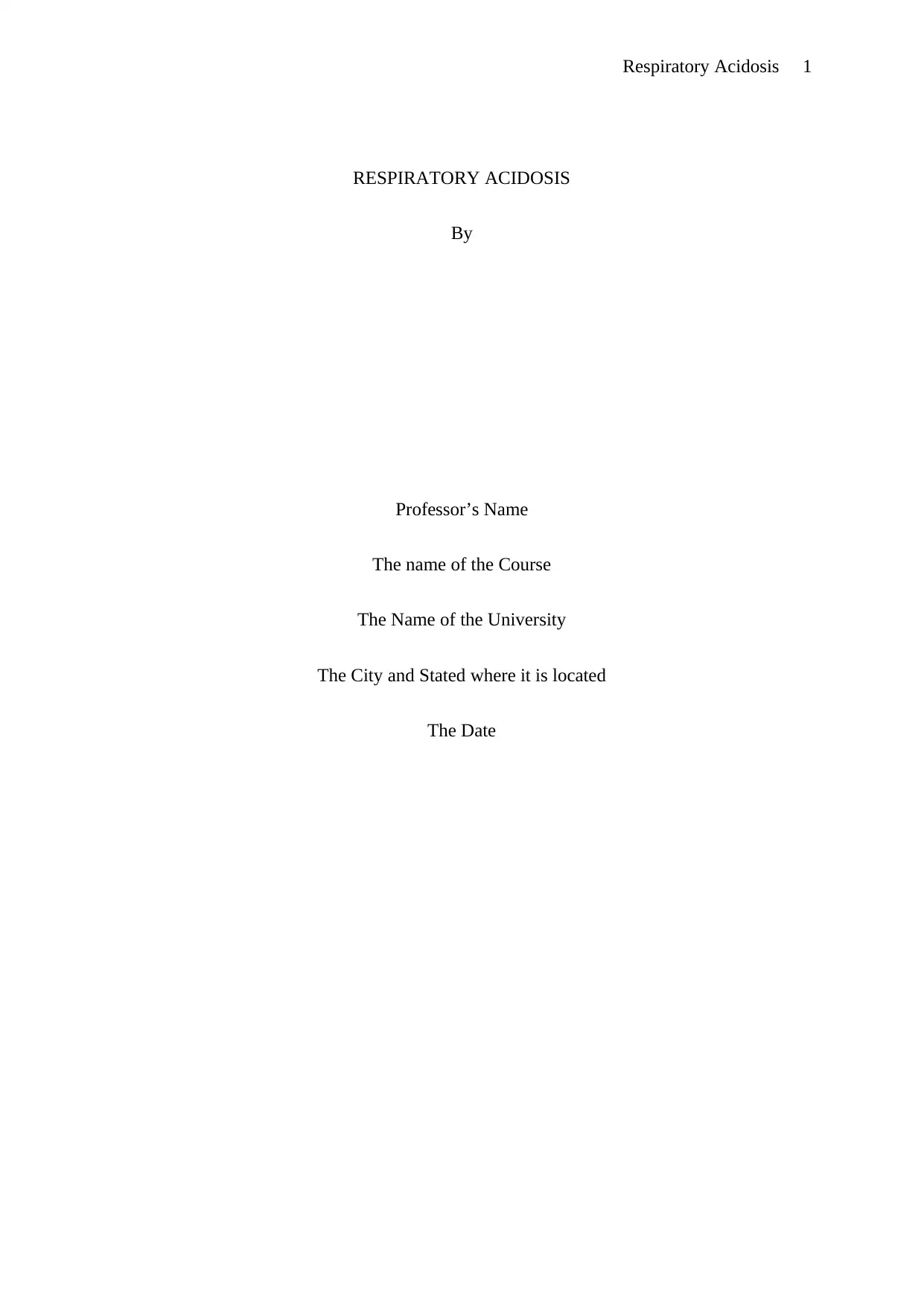
Respiratory Acidosis 1
RESPIRATORY ACIDOSIS
By
Professor’s Name
The name of the Course
The Name of the University
The City and Stated where it is located
The Date
RESPIRATORY ACIDOSIS
By
Professor’s Name
The name of the Course
The Name of the University
The City and Stated where it is located
The Date
Secure Best Marks with AI Grader
Need help grading? Try our AI Grader for instant feedback on your assignments.
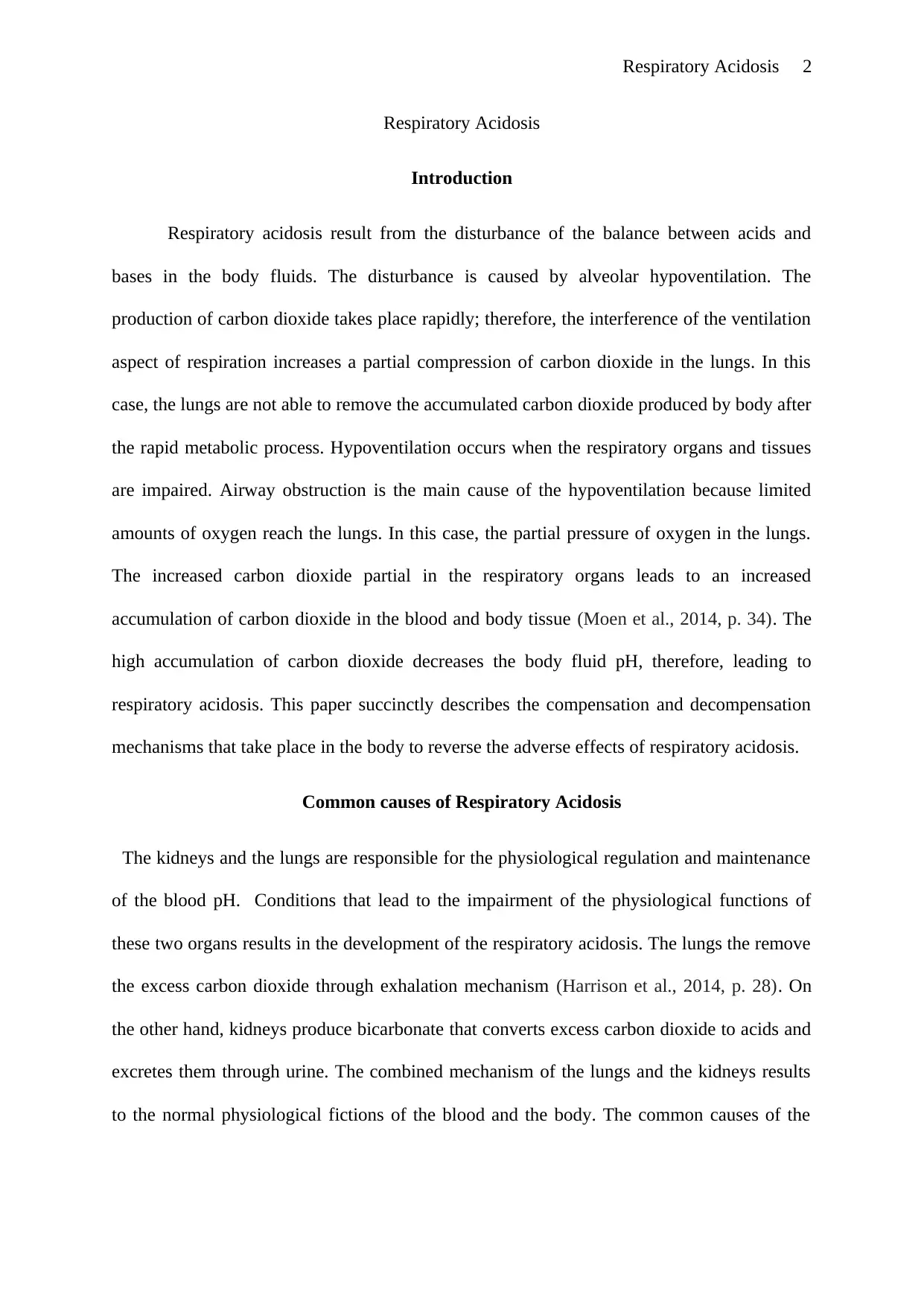
Respiratory Acidosis 2
Respiratory Acidosis
Introduction
Respiratory acidosis result from the disturbance of the balance between acids and
bases in the body fluids. The disturbance is caused by alveolar hypoventilation. The
production of carbon dioxide takes place rapidly; therefore, the interference of the ventilation
aspect of respiration increases a partial compression of carbon dioxide in the lungs. In this
case, the lungs are not able to remove the accumulated carbon dioxide produced by body after
the rapid metabolic process. Hypoventilation occurs when the respiratory organs and tissues
are impaired. Airway obstruction is the main cause of the hypoventilation because limited
amounts of oxygen reach the lungs. In this case, the partial pressure of oxygen in the lungs.
The increased carbon dioxide partial in the respiratory organs leads to an increased
accumulation of carbon dioxide in the blood and body tissue (Moen et al., 2014, p. 34). The
high accumulation of carbon dioxide decreases the body fluid pH, therefore, leading to
respiratory acidosis. This paper succinctly describes the compensation and decompensation
mechanisms that take place in the body to reverse the adverse effects of respiratory acidosis.
Common causes of Respiratory Acidosis
The kidneys and the lungs are responsible for the physiological regulation and maintenance
of the blood pH. Conditions that lead to the impairment of the physiological functions of
these two organs results in the development of the respiratory acidosis. The lungs the remove
the excess carbon dioxide through exhalation mechanism (Harrison et al., 2014, p. 28). On
the other hand, kidneys produce bicarbonate that converts excess carbon dioxide to acids and
excretes them through urine. The combined mechanism of the lungs and the kidneys results
to the normal physiological fictions of the blood and the body. The common causes of the
Respiratory Acidosis
Introduction
Respiratory acidosis result from the disturbance of the balance between acids and
bases in the body fluids. The disturbance is caused by alveolar hypoventilation. The
production of carbon dioxide takes place rapidly; therefore, the interference of the ventilation
aspect of respiration increases a partial compression of carbon dioxide in the lungs. In this
case, the lungs are not able to remove the accumulated carbon dioxide produced by body after
the rapid metabolic process. Hypoventilation occurs when the respiratory organs and tissues
are impaired. Airway obstruction is the main cause of the hypoventilation because limited
amounts of oxygen reach the lungs. In this case, the partial pressure of oxygen in the lungs.
The increased carbon dioxide partial in the respiratory organs leads to an increased
accumulation of carbon dioxide in the blood and body tissue (Moen et al., 2014, p. 34). The
high accumulation of carbon dioxide decreases the body fluid pH, therefore, leading to
respiratory acidosis. This paper succinctly describes the compensation and decompensation
mechanisms that take place in the body to reverse the adverse effects of respiratory acidosis.
Common causes of Respiratory Acidosis
The kidneys and the lungs are responsible for the physiological regulation and maintenance
of the blood pH. Conditions that lead to the impairment of the physiological functions of
these two organs results in the development of the respiratory acidosis. The lungs the remove
the excess carbon dioxide through exhalation mechanism (Harrison et al., 2014, p. 28). On
the other hand, kidneys produce bicarbonate that converts excess carbon dioxide to acids and
excretes them through urine. The combined mechanism of the lungs and the kidneys results
to the normal physiological fictions of the blood and the body. The common causes of the
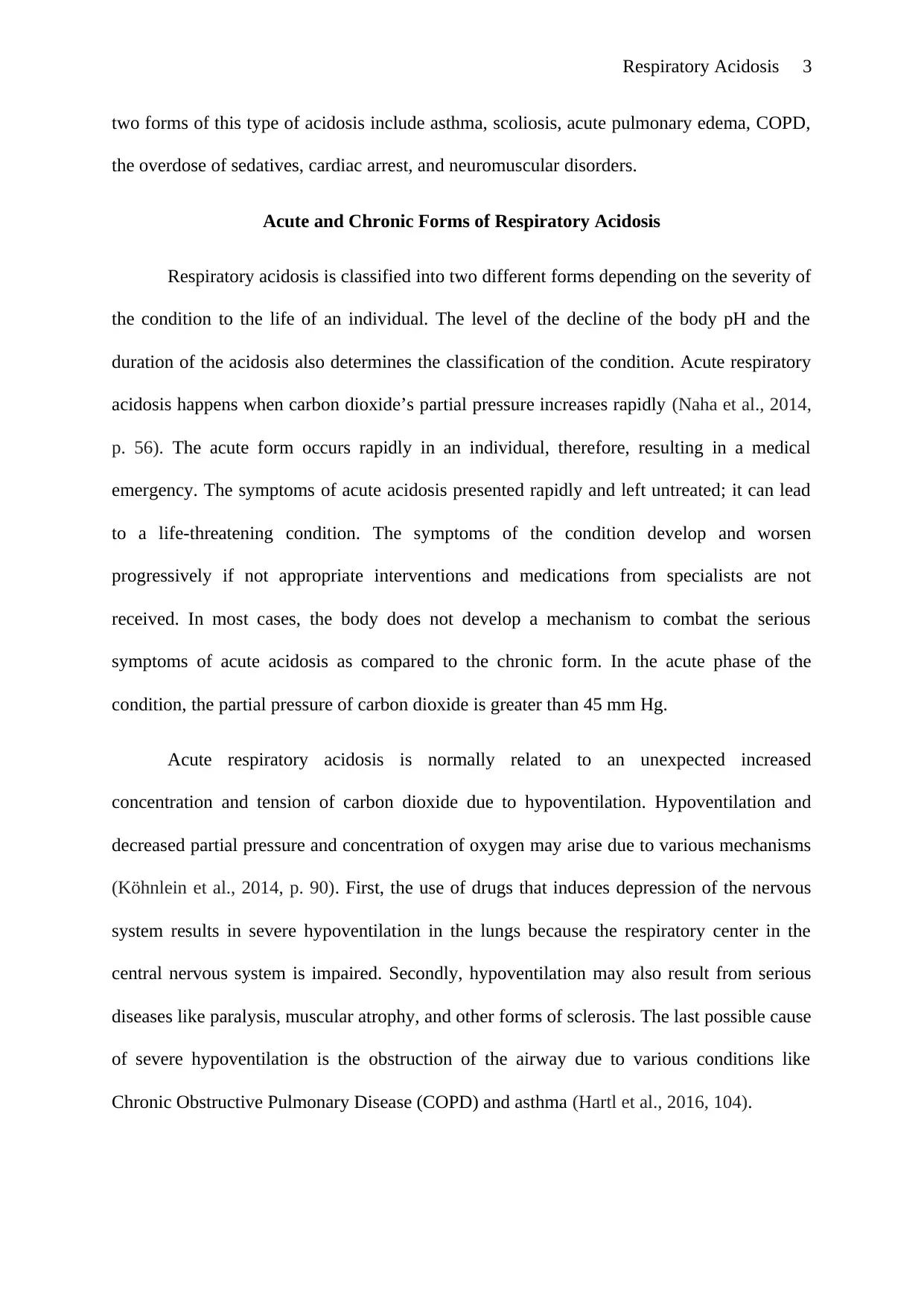
Respiratory Acidosis 3
two forms of this type of acidosis include asthma, scoliosis, acute pulmonary edema, COPD,
the overdose of sedatives, cardiac arrest, and neuromuscular disorders.
Acute and Chronic Forms of Respiratory Acidosis
Respiratory acidosis is classified into two different forms depending on the severity of
the condition to the life of an individual. The level of the decline of the body pH and the
duration of the acidosis also determines the classification of the condition. Acute respiratory
acidosis happens when carbon dioxide’s partial pressure increases rapidly (Naha et al., 2014,
p. 56). The acute form occurs rapidly in an individual, therefore, resulting in a medical
emergency. The symptoms of acute acidosis presented rapidly and left untreated; it can lead
to a life-threatening condition. The symptoms of the condition develop and worsen
progressively if not appropriate interventions and medications from specialists are not
received. In most cases, the body does not develop a mechanism to combat the serious
symptoms of acute acidosis as compared to the chronic form. In the acute phase of the
condition, the partial pressure of carbon dioxide is greater than 45 mm Hg.
Acute respiratory acidosis is normally related to an unexpected increased
concentration and tension of carbon dioxide due to hypoventilation. Hypoventilation and
decreased partial pressure and concentration of oxygen may arise due to various mechanisms
(Köhnlein et al., 2014, p. 90). First, the use of drugs that induces depression of the nervous
system results in severe hypoventilation in the lungs because the respiratory center in the
central nervous system is impaired. Secondly, hypoventilation may also result from serious
diseases like paralysis, muscular atrophy, and other forms of sclerosis. The last possible cause
of severe hypoventilation is the obstruction of the airway due to various conditions like
Chronic Obstructive Pulmonary Disease (COPD) and asthma (Hartl et al., 2016, 104).
two forms of this type of acidosis include asthma, scoliosis, acute pulmonary edema, COPD,
the overdose of sedatives, cardiac arrest, and neuromuscular disorders.
Acute and Chronic Forms of Respiratory Acidosis
Respiratory acidosis is classified into two different forms depending on the severity of
the condition to the life of an individual. The level of the decline of the body pH and the
duration of the acidosis also determines the classification of the condition. Acute respiratory
acidosis happens when carbon dioxide’s partial pressure increases rapidly (Naha et al., 2014,
p. 56). The acute form occurs rapidly in an individual, therefore, resulting in a medical
emergency. The symptoms of acute acidosis presented rapidly and left untreated; it can lead
to a life-threatening condition. The symptoms of the condition develop and worsen
progressively if not appropriate interventions and medications from specialists are not
received. In most cases, the body does not develop a mechanism to combat the serious
symptoms of acute acidosis as compared to the chronic form. In the acute phase of the
condition, the partial pressure of carbon dioxide is greater than 45 mm Hg.
Acute respiratory acidosis is normally related to an unexpected increased
concentration and tension of carbon dioxide due to hypoventilation. Hypoventilation and
decreased partial pressure and concentration of oxygen may arise due to various mechanisms
(Köhnlein et al., 2014, p. 90). First, the use of drugs that induces depression of the nervous
system results in severe hypoventilation in the lungs because the respiratory center in the
central nervous system is impaired. Secondly, hypoventilation may also result from serious
diseases like paralysis, muscular atrophy, and other forms of sclerosis. The last possible cause
of severe hypoventilation is the obstruction of the airway due to various conditions like
Chronic Obstructive Pulmonary Disease (COPD) and asthma (Hartl et al., 2016, 104).
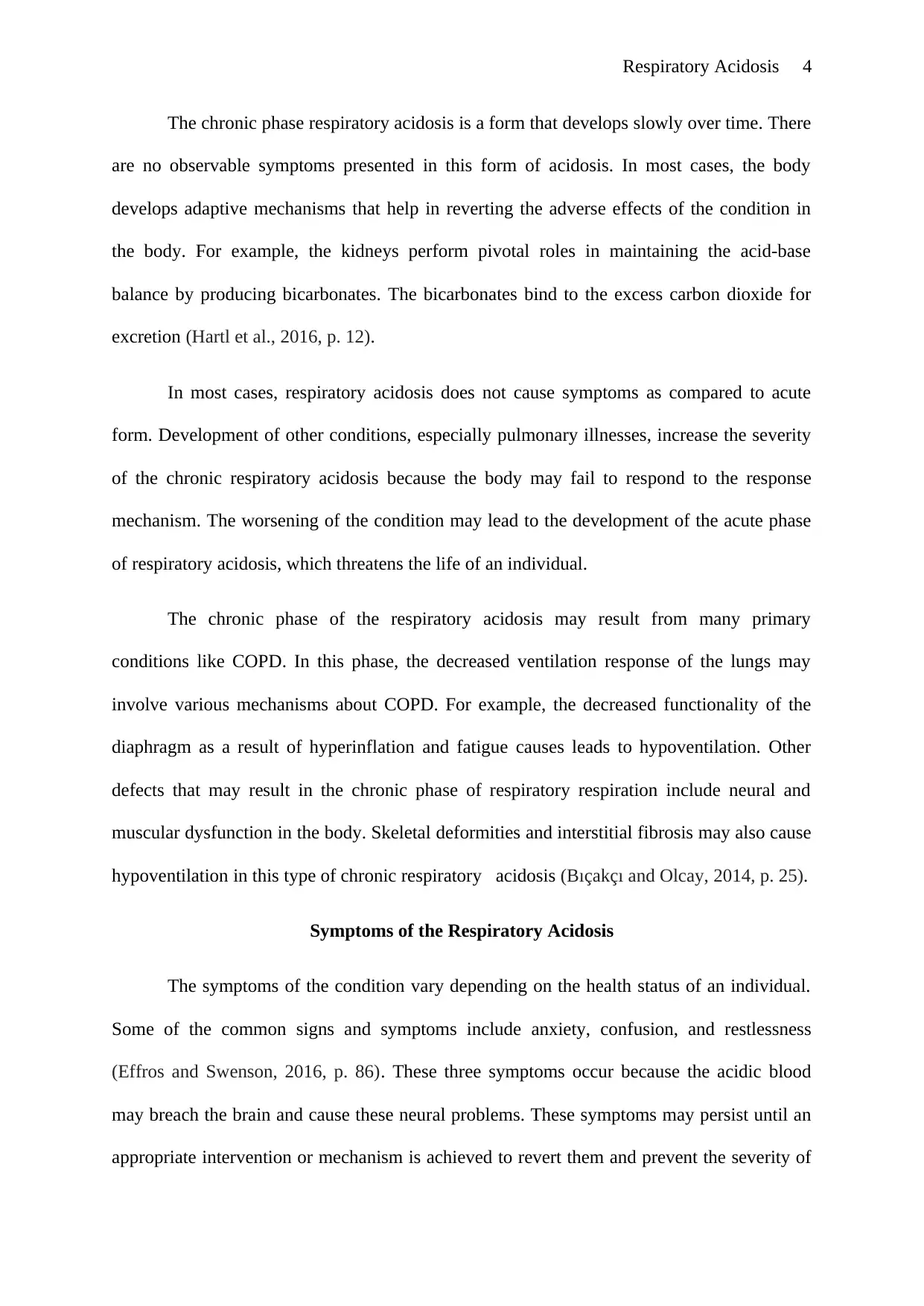
Respiratory Acidosis 4
The chronic phase respiratory acidosis is a form that develops slowly over time. There
are no observable symptoms presented in this form of acidosis. In most cases, the body
develops adaptive mechanisms that help in reverting the adverse effects of the condition in
the body. For example, the kidneys perform pivotal roles in maintaining the acid-base
balance by producing bicarbonates. The bicarbonates bind to the excess carbon dioxide for
excretion (Hartl et al., 2016, p. 12).
In most cases, respiratory acidosis does not cause symptoms as compared to acute
form. Development of other conditions, especially pulmonary illnesses, increase the severity
of the chronic respiratory acidosis because the body may fail to respond to the response
mechanism. The worsening of the condition may lead to the development of the acute phase
of respiratory acidosis, which threatens the life of an individual.
The chronic phase of the respiratory acidosis may result from many primary
conditions like COPD. In this phase, the decreased ventilation response of the lungs may
involve various mechanisms about COPD. For example, the decreased functionality of the
diaphragm as a result of hyperinflation and fatigue causes leads to hypoventilation. Other
defects that may result in the chronic phase of respiratory respiration include neural and
muscular dysfunction in the body. Skeletal deformities and interstitial fibrosis may also cause
hypoventilation in this type of chronic respiratory acidosis (Bıçakçı and Olcay, 2014, p. 25).
Symptoms of the Respiratory Acidosis
The symptoms of the condition vary depending on the health status of an individual.
Some of the common signs and symptoms include anxiety, confusion, and restlessness
(Effros and Swenson, 2016, p. 86). These three symptoms occur because the acidic blood
may breach the brain and cause these neural problems. These symptoms may persist until an
appropriate intervention or mechanism is achieved to revert them and prevent the severity of
The chronic phase respiratory acidosis is a form that develops slowly over time. There
are no observable symptoms presented in this form of acidosis. In most cases, the body
develops adaptive mechanisms that help in reverting the adverse effects of the condition in
the body. For example, the kidneys perform pivotal roles in maintaining the acid-base
balance by producing bicarbonates. The bicarbonates bind to the excess carbon dioxide for
excretion (Hartl et al., 2016, p. 12).
In most cases, respiratory acidosis does not cause symptoms as compared to acute
form. Development of other conditions, especially pulmonary illnesses, increase the severity
of the chronic respiratory acidosis because the body may fail to respond to the response
mechanism. The worsening of the condition may lead to the development of the acute phase
of respiratory acidosis, which threatens the life of an individual.
The chronic phase of the respiratory acidosis may result from many primary
conditions like COPD. In this phase, the decreased ventilation response of the lungs may
involve various mechanisms about COPD. For example, the decreased functionality of the
diaphragm as a result of hyperinflation and fatigue causes leads to hypoventilation. Other
defects that may result in the chronic phase of respiratory respiration include neural and
muscular dysfunction in the body. Skeletal deformities and interstitial fibrosis may also cause
hypoventilation in this type of chronic respiratory acidosis (Bıçakçı and Olcay, 2014, p. 25).
Symptoms of the Respiratory Acidosis
The symptoms of the condition vary depending on the health status of an individual.
Some of the common signs and symptoms include anxiety, confusion, and restlessness
(Effros and Swenson, 2016, p. 86). These three symptoms occur because the acidic blood
may breach the brain and cause these neural problems. These symptoms may persist until an
appropriate intervention or mechanism is achieved to revert them and prevent the severity of
Secure Best Marks with AI Grader
Need help grading? Try our AI Grader for instant feedback on your assignments.
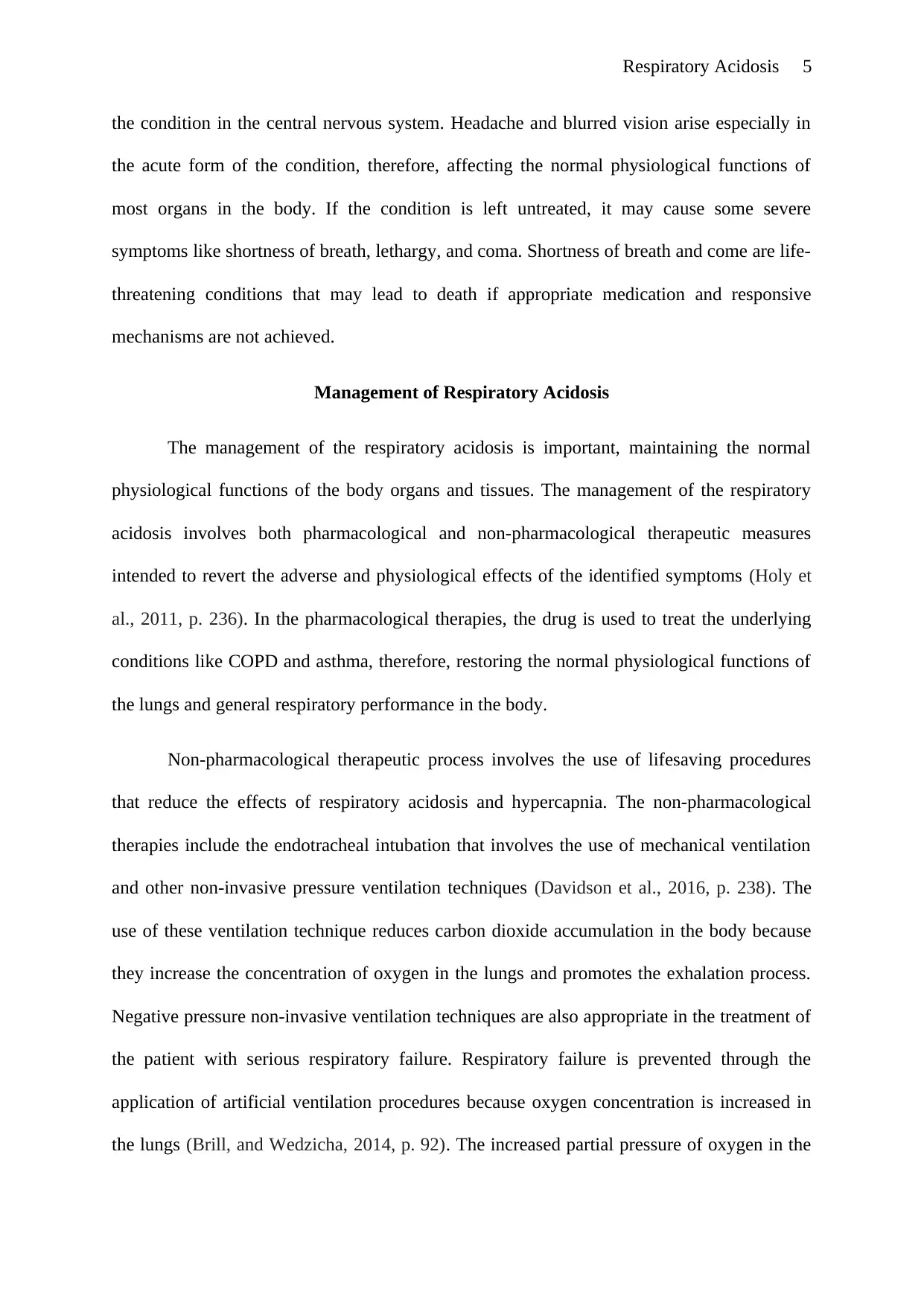
Respiratory Acidosis 5
the condition in the central nervous system. Headache and blurred vision arise especially in
the acute form of the condition, therefore, affecting the normal physiological functions of
most organs in the body. If the condition is left untreated, it may cause some severe
symptoms like shortness of breath, lethargy, and coma. Shortness of breath and come are life-
threatening conditions that may lead to death if appropriate medication and responsive
mechanisms are not achieved.
Management of Respiratory Acidosis
The management of the respiratory acidosis is important, maintaining the normal
physiological functions of the body organs and tissues. The management of the respiratory
acidosis involves both pharmacological and non-pharmacological therapeutic measures
intended to revert the adverse and physiological effects of the identified symptoms (Holy et
al., 2011, p. 236). In the pharmacological therapies, the drug is used to treat the underlying
conditions like COPD and asthma, therefore, restoring the normal physiological functions of
the lungs and general respiratory performance in the body.
Non-pharmacological therapeutic process involves the use of lifesaving procedures
that reduce the effects of respiratory acidosis and hypercapnia. The non-pharmacological
therapies include the endotracheal intubation that involves the use of mechanical ventilation
and other non-invasive pressure ventilation techniques (Davidson et al., 2016, p. 238). The
use of these ventilation technique reduces carbon dioxide accumulation in the body because
they increase the concentration of oxygen in the lungs and promotes the exhalation process.
Negative pressure non-invasive ventilation techniques are also appropriate in the treatment of
the patient with serious respiratory failure. Respiratory failure is prevented through the
application of artificial ventilation procedures because oxygen concentration is increased in
the lungs (Brill, and Wedzicha, 2014, p. 92). The increased partial pressure of oxygen in the
the condition in the central nervous system. Headache and blurred vision arise especially in
the acute form of the condition, therefore, affecting the normal physiological functions of
most organs in the body. If the condition is left untreated, it may cause some severe
symptoms like shortness of breath, lethargy, and coma. Shortness of breath and come are life-
threatening conditions that may lead to death if appropriate medication and responsive
mechanisms are not achieved.
Management of Respiratory Acidosis
The management of the respiratory acidosis is important, maintaining the normal
physiological functions of the body organs and tissues. The management of the respiratory
acidosis involves both pharmacological and non-pharmacological therapeutic measures
intended to revert the adverse and physiological effects of the identified symptoms (Holy et
al., 2011, p. 236). In the pharmacological therapies, the drug is used to treat the underlying
conditions like COPD and asthma, therefore, restoring the normal physiological functions of
the lungs and general respiratory performance in the body.
Non-pharmacological therapeutic process involves the use of lifesaving procedures
that reduce the effects of respiratory acidosis and hypercapnia. The non-pharmacological
therapies include the endotracheal intubation that involves the use of mechanical ventilation
and other non-invasive pressure ventilation techniques (Davidson et al., 2016, p. 238). The
use of these ventilation technique reduces carbon dioxide accumulation in the body because
they increase the concentration of oxygen in the lungs and promotes the exhalation process.
Negative pressure non-invasive ventilation techniques are also appropriate in the treatment of
the patient with serious respiratory failure. Respiratory failure is prevented through the
application of artificial ventilation procedures because oxygen concentration is increased in
the lungs (Brill, and Wedzicha, 2014, p. 92). The increased partial pressure of oxygen in the
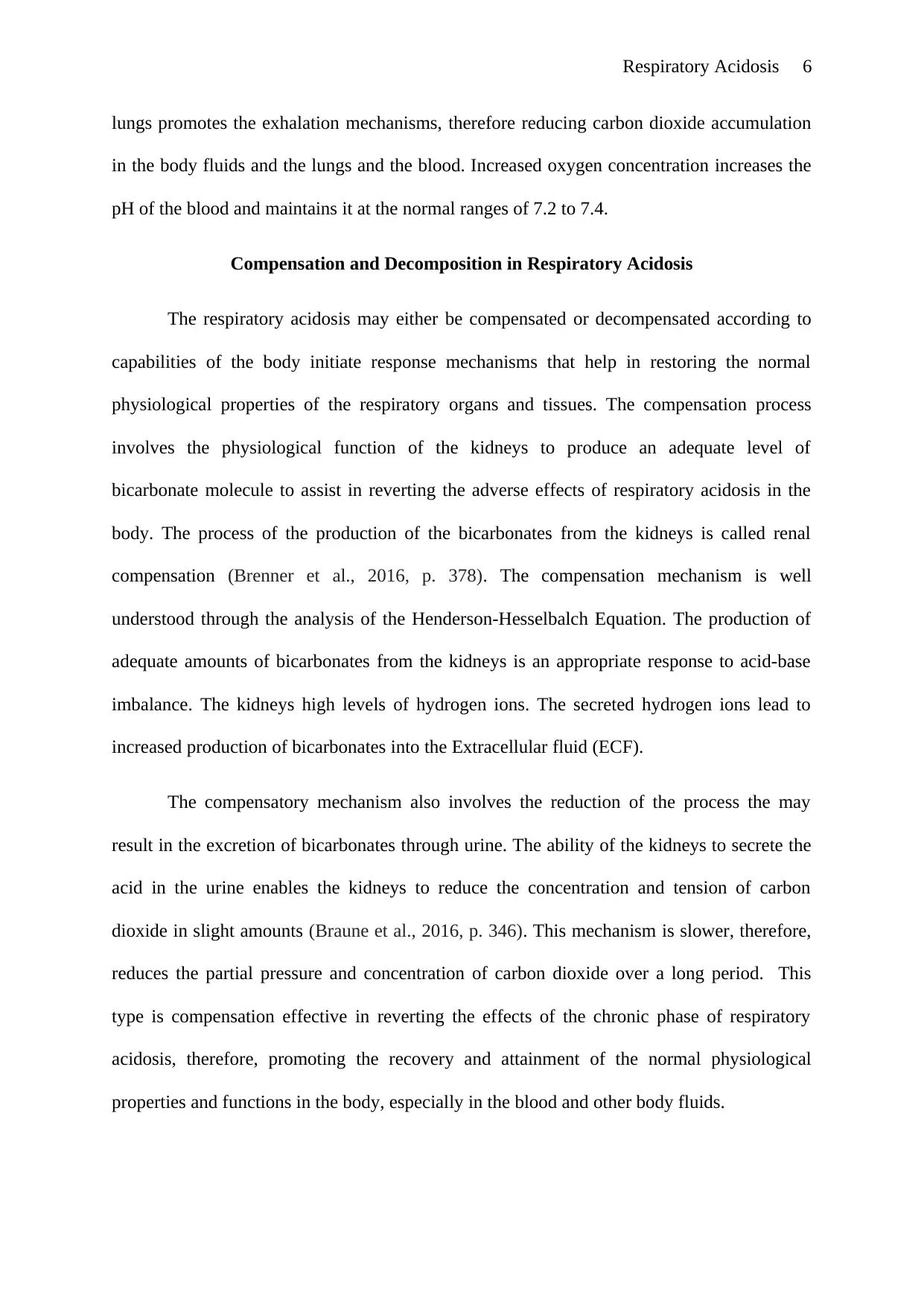
Respiratory Acidosis 6
lungs promotes the exhalation mechanisms, therefore reducing carbon dioxide accumulation
in the body fluids and the lungs and the blood. Increased oxygen concentration increases the
pH of the blood and maintains it at the normal ranges of 7.2 to 7.4.
Compensation and Decomposition in Respiratory Acidosis
The respiratory acidosis may either be compensated or decompensated according to
capabilities of the body initiate response mechanisms that help in restoring the normal
physiological properties of the respiratory organs and tissues. The compensation process
involves the physiological function of the kidneys to produce an adequate level of
bicarbonate molecule to assist in reverting the adverse effects of respiratory acidosis in the
body. The process of the production of the bicarbonates from the kidneys is called renal
compensation (Brenner et al., 2016, p. 378). The compensation mechanism is well
understood through the analysis of the Henderson-Hesselbalch Equation. The production of
adequate amounts of bicarbonates from the kidneys is an appropriate response to acid-base
imbalance. The kidneys high levels of hydrogen ions. The secreted hydrogen ions lead to
increased production of bicarbonates into the Extracellular fluid (ECF).
The compensatory mechanism also involves the reduction of the process the may
result in the excretion of bicarbonates through urine. The ability of the kidneys to secrete the
acid in the urine enables the kidneys to reduce the concentration and tension of carbon
dioxide in slight amounts (Braune et al., 2016, p. 346). This mechanism is slower, therefore,
reduces the partial pressure and concentration of carbon dioxide over a long period. This
type is compensation effective in reverting the effects of the chronic phase of respiratory
acidosis, therefore, promoting the recovery and attainment of the normal physiological
properties and functions in the body, especially in the blood and other body fluids.
lungs promotes the exhalation mechanisms, therefore reducing carbon dioxide accumulation
in the body fluids and the lungs and the blood. Increased oxygen concentration increases the
pH of the blood and maintains it at the normal ranges of 7.2 to 7.4.
Compensation and Decomposition in Respiratory Acidosis
The respiratory acidosis may either be compensated or decompensated according to
capabilities of the body initiate response mechanisms that help in restoring the normal
physiological properties of the respiratory organs and tissues. The compensation process
involves the physiological function of the kidneys to produce an adequate level of
bicarbonate molecule to assist in reverting the adverse effects of respiratory acidosis in the
body. The process of the production of the bicarbonates from the kidneys is called renal
compensation (Brenner et al., 2016, p. 378). The compensation mechanism is well
understood through the analysis of the Henderson-Hesselbalch Equation. The production of
adequate amounts of bicarbonates from the kidneys is an appropriate response to acid-base
imbalance. The kidneys high levels of hydrogen ions. The secreted hydrogen ions lead to
increased production of bicarbonates into the Extracellular fluid (ECF).
The compensatory mechanism also involves the reduction of the process the may
result in the excretion of bicarbonates through urine. The ability of the kidneys to secrete the
acid in the urine enables the kidneys to reduce the concentration and tension of carbon
dioxide in slight amounts (Braune et al., 2016, p. 346). This mechanism is slower, therefore,
reduces the partial pressure and concentration of carbon dioxide over a long period. This
type is compensation effective in reverting the effects of the chronic phase of respiratory
acidosis, therefore, promoting the recovery and attainment of the normal physiological
properties and functions in the body, especially in the blood and other body fluids.
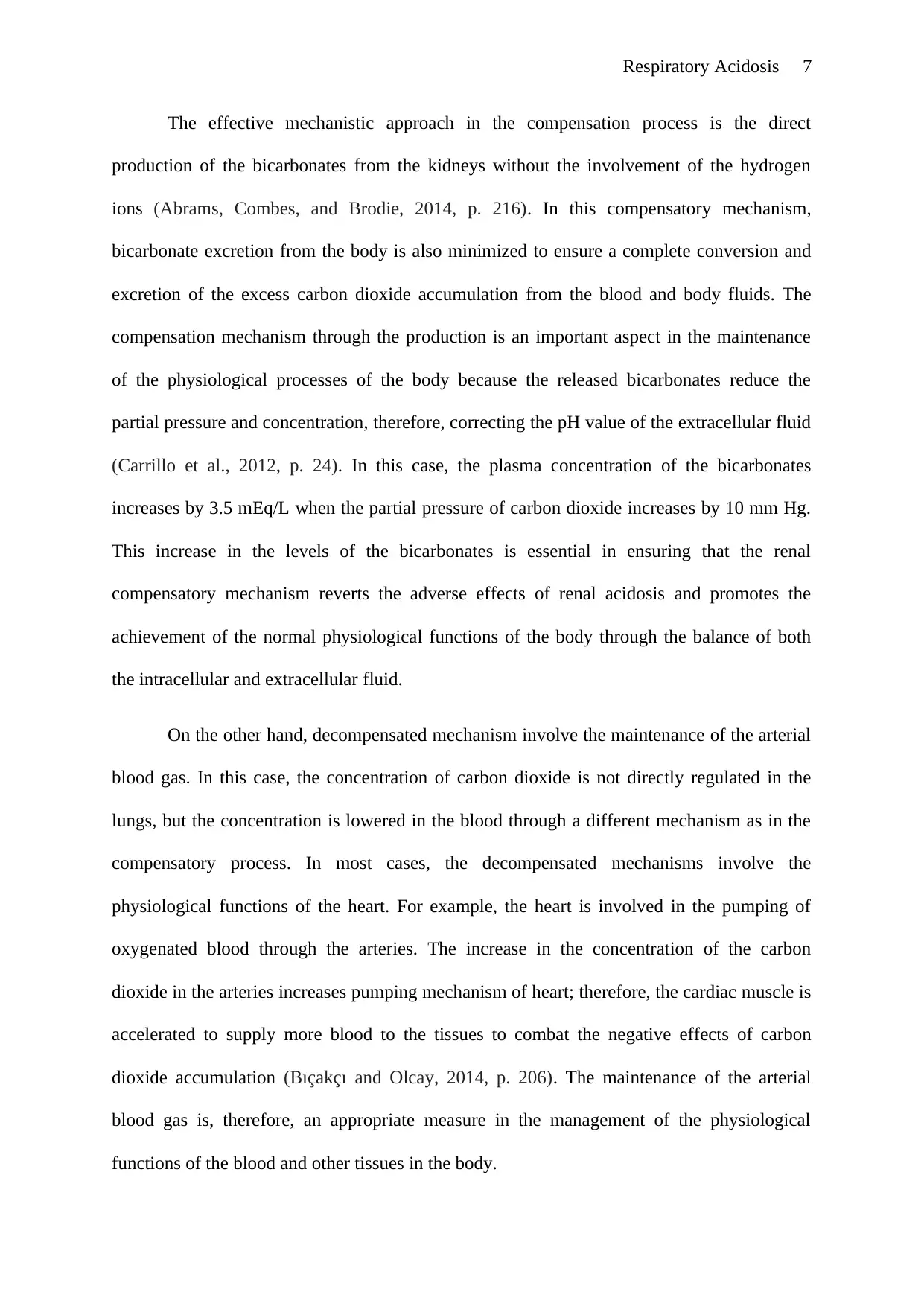
Respiratory Acidosis 7
The effective mechanistic approach in the compensation process is the direct
production of the bicarbonates from the kidneys without the involvement of the hydrogen
ions (Abrams, Combes, and Brodie, 2014, p. 216). In this compensatory mechanism,
bicarbonate excretion from the body is also minimized to ensure a complete conversion and
excretion of the excess carbon dioxide accumulation from the blood and body fluids. The
compensation mechanism through the production is an important aspect in the maintenance
of the physiological processes of the body because the released bicarbonates reduce the
partial pressure and concentration, therefore, correcting the pH value of the extracellular fluid
(Carrillo et al., 2012, p. 24). In this case, the plasma concentration of the bicarbonates
increases by 3.5 mEq/L when the partial pressure of carbon dioxide increases by 10 mm Hg.
This increase in the levels of the bicarbonates is essential in ensuring that the renal
compensatory mechanism reverts the adverse effects of renal acidosis and promotes the
achievement of the normal physiological functions of the body through the balance of both
the intracellular and extracellular fluid.
On the other hand, decompensated mechanism involve the maintenance of the arterial
blood gas. In this case, the concentration of carbon dioxide is not directly regulated in the
lungs, but the concentration is lowered in the blood through a different mechanism as in the
compensatory process. In most cases, the decompensated mechanisms involve the
physiological functions of the heart. For example, the heart is involved in the pumping of
oxygenated blood through the arteries. The increase in the concentration of the carbon
dioxide in the arteries increases pumping mechanism of heart; therefore, the cardiac muscle is
accelerated to supply more blood to the tissues to combat the negative effects of carbon
dioxide accumulation (Bıçakçı and Olcay, 2014, p. 206). The maintenance of the arterial
blood gas is, therefore, an appropriate measure in the management of the physiological
functions of the blood and other tissues in the body.
The effective mechanistic approach in the compensation process is the direct
production of the bicarbonates from the kidneys without the involvement of the hydrogen
ions (Abrams, Combes, and Brodie, 2014, p. 216). In this compensatory mechanism,
bicarbonate excretion from the body is also minimized to ensure a complete conversion and
excretion of the excess carbon dioxide accumulation from the blood and body fluids. The
compensation mechanism through the production is an important aspect in the maintenance
of the physiological processes of the body because the released bicarbonates reduce the
partial pressure and concentration, therefore, correcting the pH value of the extracellular fluid
(Carrillo et al., 2012, p. 24). In this case, the plasma concentration of the bicarbonates
increases by 3.5 mEq/L when the partial pressure of carbon dioxide increases by 10 mm Hg.
This increase in the levels of the bicarbonates is essential in ensuring that the renal
compensatory mechanism reverts the adverse effects of renal acidosis and promotes the
achievement of the normal physiological functions of the body through the balance of both
the intracellular and extracellular fluid.
On the other hand, decompensated mechanism involve the maintenance of the arterial
blood gas. In this case, the concentration of carbon dioxide is not directly regulated in the
lungs, but the concentration is lowered in the blood through a different mechanism as in the
compensatory process. In most cases, the decompensated mechanisms involve the
physiological functions of the heart. For example, the heart is involved in the pumping of
oxygenated blood through the arteries. The increase in the concentration of the carbon
dioxide in the arteries increases pumping mechanism of heart; therefore, the cardiac muscle is
accelerated to supply more blood to the tissues to combat the negative effects of carbon
dioxide accumulation (Bıçakçı and Olcay, 2014, p. 206). The maintenance of the arterial
blood gas is, therefore, an appropriate measure in the management of the physiological
functions of the blood and other tissues in the body.
Paraphrase This Document
Need a fresh take? Get an instant paraphrase of this document with our AI Paraphraser
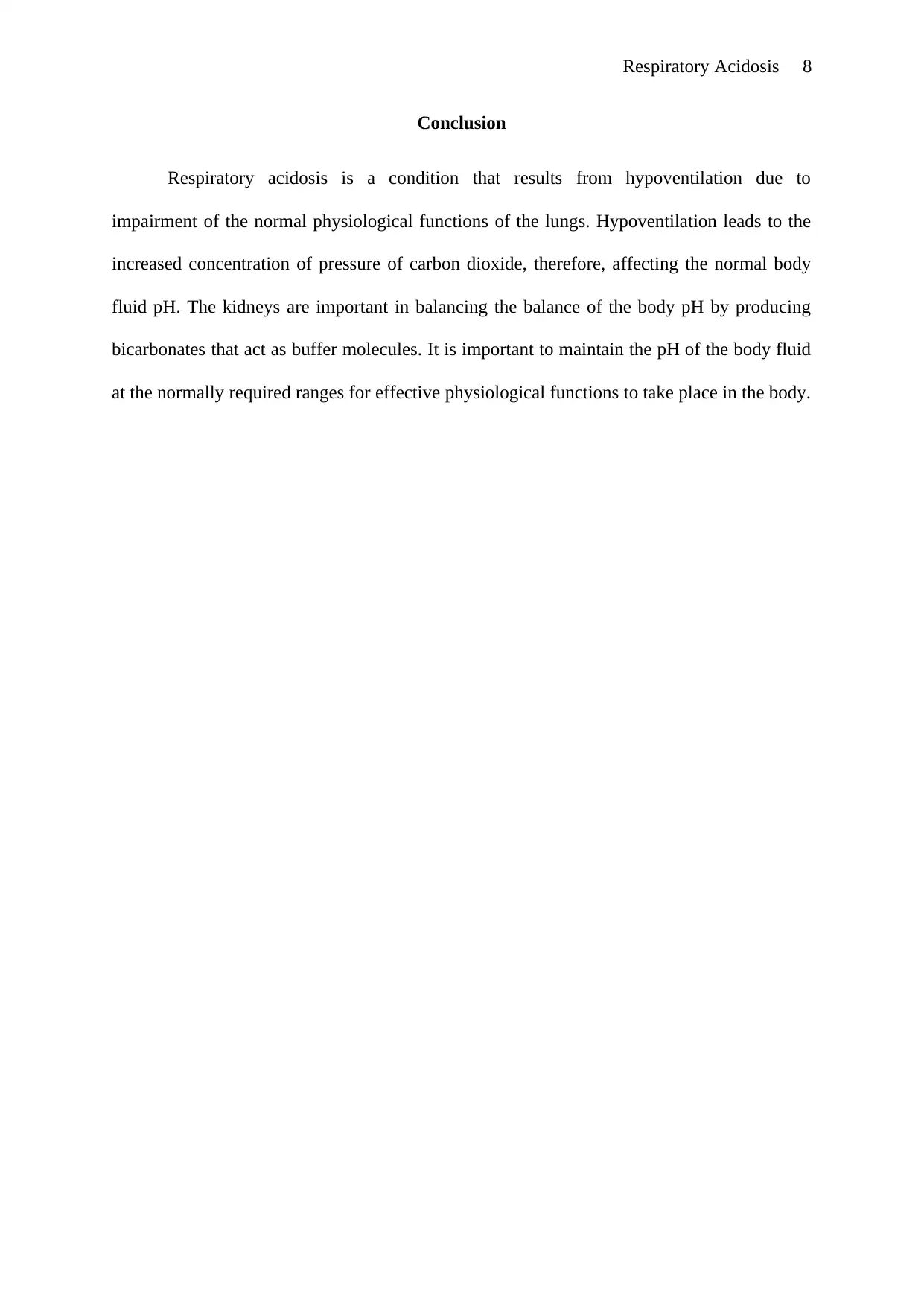
Respiratory Acidosis 8
Conclusion
Respiratory acidosis is a condition that results from hypoventilation due to
impairment of the normal physiological functions of the lungs. Hypoventilation leads to the
increased concentration of pressure of carbon dioxide, therefore, affecting the normal body
fluid pH. The kidneys are important in balancing the balance of the body pH by producing
bicarbonates that act as buffer molecules. It is important to maintain the pH of the body fluid
at the normally required ranges for effective physiological functions to take place in the body.
Conclusion
Respiratory acidosis is a condition that results from hypoventilation due to
impairment of the normal physiological functions of the lungs. Hypoventilation leads to the
increased concentration of pressure of carbon dioxide, therefore, affecting the normal body
fluid pH. The kidneys are important in balancing the balance of the body pH by producing
bicarbonates that act as buffer molecules. It is important to maintain the pH of the body fluid
at the normally required ranges for effective physiological functions to take place in the body.
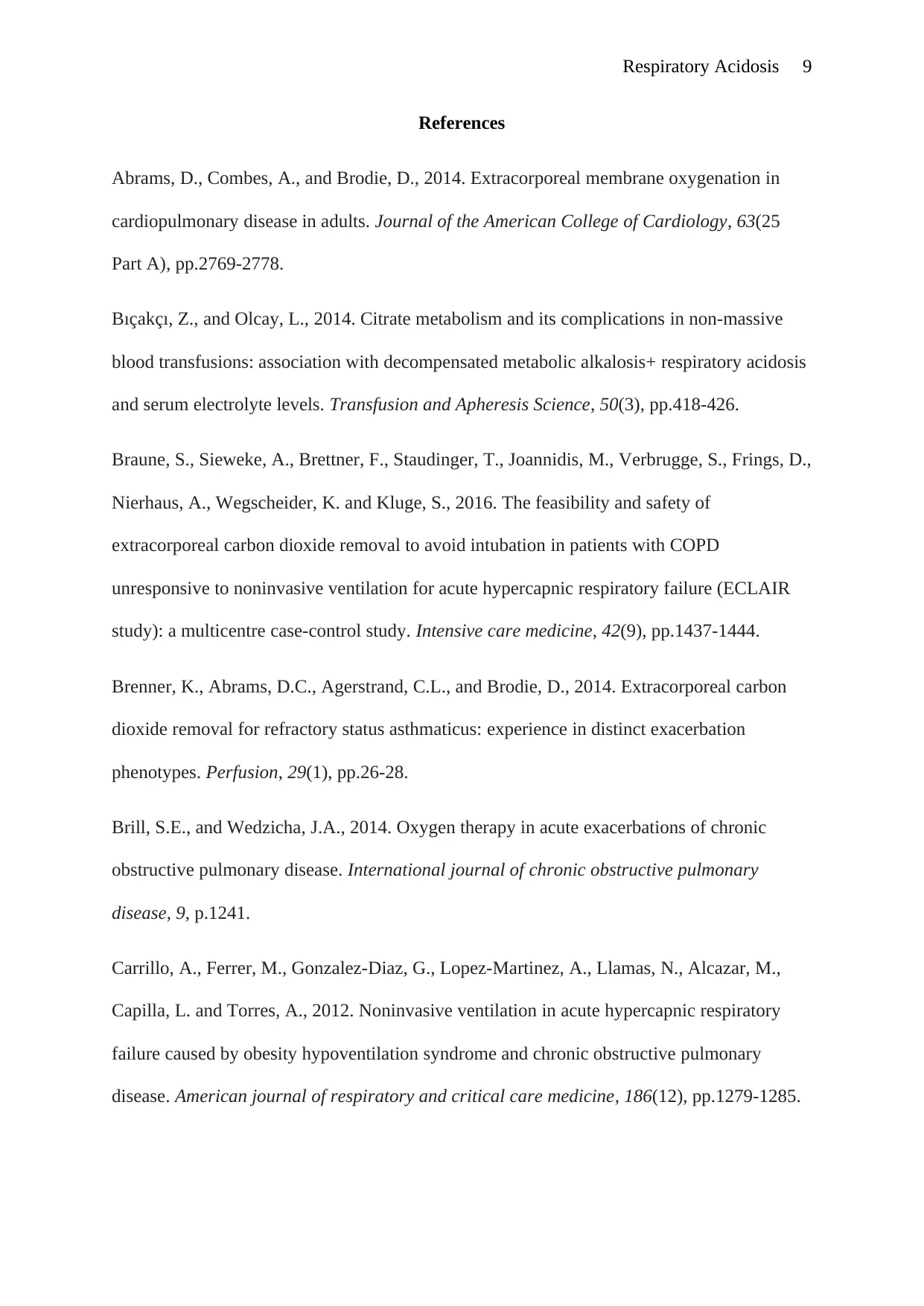
Respiratory Acidosis 9
References
Abrams, D., Combes, A., and Brodie, D., 2014. Extracorporeal membrane oxygenation in
cardiopulmonary disease in adults. Journal of the American College of Cardiology, 63(25
Part A), pp.2769-2778.
Bıçakçı, Z., and Olcay, L., 2014. Citrate metabolism and its complications in non-massive
blood transfusions: association with decompensated metabolic alkalosis+ respiratory acidosis
and serum electrolyte levels. Transfusion and Apheresis Science, 50(3), pp.418-426.
Braune, S., Sieweke, A., Brettner, F., Staudinger, T., Joannidis, M., Verbrugge, S., Frings, D.,
Nierhaus, A., Wegscheider, K. and Kluge, S., 2016. The feasibility and safety of
extracorporeal carbon dioxide removal to avoid intubation in patients with COPD
unresponsive to noninvasive ventilation for acute hypercapnic respiratory failure (ECLAIR
study): a multicentre case-control study. Intensive care medicine, 42(9), pp.1437-1444.
Brenner, K., Abrams, D.C., Agerstrand, C.L., and Brodie, D., 2014. Extracorporeal carbon
dioxide removal for refractory status asthmaticus: experience in distinct exacerbation
phenotypes. Perfusion, 29(1), pp.26-28.
Brill, S.E., and Wedzicha, J.A., 2014. Oxygen therapy in acute exacerbations of chronic
obstructive pulmonary disease. International journal of chronic obstructive pulmonary
disease, 9, p.1241.
Carrillo, A., Ferrer, M., Gonzalez-Diaz, G., Lopez-Martinez, A., Llamas, N., Alcazar, M.,
Capilla, L. and Torres, A., 2012. Noninvasive ventilation in acute hypercapnic respiratory
failure caused by obesity hypoventilation syndrome and chronic obstructive pulmonary
disease. American journal of respiratory and critical care medicine, 186(12), pp.1279-1285.
References
Abrams, D., Combes, A., and Brodie, D., 2014. Extracorporeal membrane oxygenation in
cardiopulmonary disease in adults. Journal of the American College of Cardiology, 63(25
Part A), pp.2769-2778.
Bıçakçı, Z., and Olcay, L., 2014. Citrate metabolism and its complications in non-massive
blood transfusions: association with decompensated metabolic alkalosis+ respiratory acidosis
and serum electrolyte levels. Transfusion and Apheresis Science, 50(3), pp.418-426.
Braune, S., Sieweke, A., Brettner, F., Staudinger, T., Joannidis, M., Verbrugge, S., Frings, D.,
Nierhaus, A., Wegscheider, K. and Kluge, S., 2016. The feasibility and safety of
extracorporeal carbon dioxide removal to avoid intubation in patients with COPD
unresponsive to noninvasive ventilation for acute hypercapnic respiratory failure (ECLAIR
study): a multicentre case-control study. Intensive care medicine, 42(9), pp.1437-1444.
Brenner, K., Abrams, D.C., Agerstrand, C.L., and Brodie, D., 2014. Extracorporeal carbon
dioxide removal for refractory status asthmaticus: experience in distinct exacerbation
phenotypes. Perfusion, 29(1), pp.26-28.
Brill, S.E., and Wedzicha, J.A., 2014. Oxygen therapy in acute exacerbations of chronic
obstructive pulmonary disease. International journal of chronic obstructive pulmonary
disease, 9, p.1241.
Carrillo, A., Ferrer, M., Gonzalez-Diaz, G., Lopez-Martinez, A., Llamas, N., Alcazar, M.,
Capilla, L. and Torres, A., 2012. Noninvasive ventilation in acute hypercapnic respiratory
failure caused by obesity hypoventilation syndrome and chronic obstructive pulmonary
disease. American journal of respiratory and critical care medicine, 186(12), pp.1279-1285.
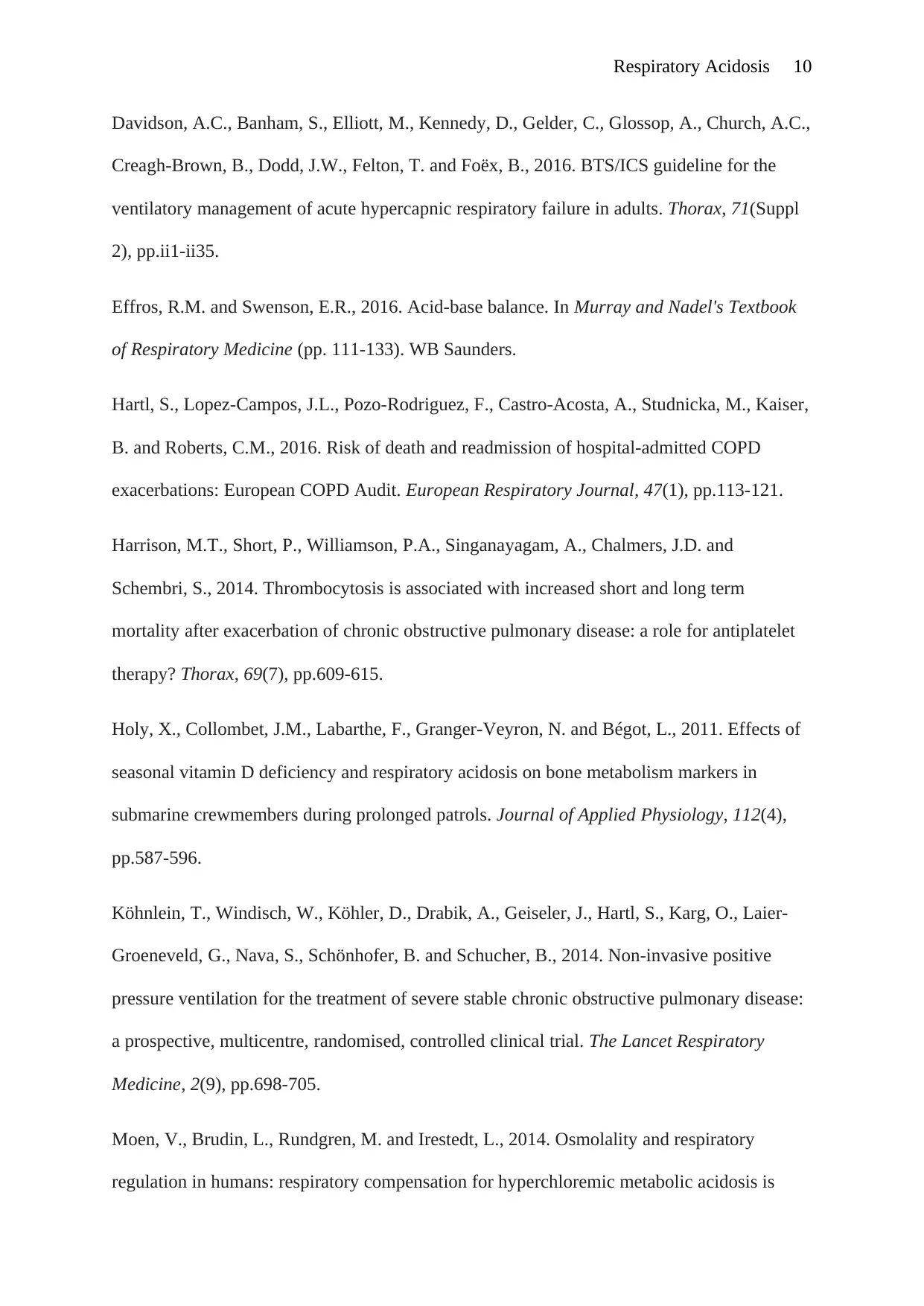
Respiratory Acidosis 10
Davidson, A.C., Banham, S., Elliott, M., Kennedy, D., Gelder, C., Glossop, A., Church, A.C.,
Creagh-Brown, B., Dodd, J.W., Felton, T. and Foëx, B., 2016. BTS/ICS guideline for the
ventilatory management of acute hypercapnic respiratory failure in adults. Thorax, 71(Suppl
2), pp.ii1-ii35.
Effros, R.M. and Swenson, E.R., 2016. Acid-base balance. In Murray and Nadel's Textbook
of Respiratory Medicine (pp. 111-133). WB Saunders.
Hartl, S., Lopez-Campos, J.L., Pozo-Rodriguez, F., Castro-Acosta, A., Studnicka, M., Kaiser,
B. and Roberts, C.M., 2016. Risk of death and readmission of hospital-admitted COPD
exacerbations: European COPD Audit. European Respiratory Journal, 47(1), pp.113-121.
Harrison, M.T., Short, P., Williamson, P.A., Singanayagam, A., Chalmers, J.D. and
Schembri, S., 2014. Thrombocytosis is associated with increased short and long term
mortality after exacerbation of chronic obstructive pulmonary disease: a role for antiplatelet
therapy? Thorax, 69(7), pp.609-615.
Holy, X., Collombet, J.M., Labarthe, F., Granger-Veyron, N. and Bégot, L., 2011. Effects of
seasonal vitamin D deficiency and respiratory acidosis on bone metabolism markers in
submarine crewmembers during prolonged patrols. Journal of Applied Physiology, 112(4),
pp.587-596.
Köhnlein, T., Windisch, W., Köhler, D., Drabik, A., Geiseler, J., Hartl, S., Karg, O., Laier-
Groeneveld, G., Nava, S., Schönhofer, B. and Schucher, B., 2014. Non-invasive positive
pressure ventilation for the treatment of severe stable chronic obstructive pulmonary disease:
a prospective, multicentre, randomised, controlled clinical trial. The Lancet Respiratory
Medicine, 2(9), pp.698-705.
Moen, V., Brudin, L., Rundgren, M. and Irestedt, L., 2014. Osmolality and respiratory
regulation in humans: respiratory compensation for hyperchloremic metabolic acidosis is
Davidson, A.C., Banham, S., Elliott, M., Kennedy, D., Gelder, C., Glossop, A., Church, A.C.,
Creagh-Brown, B., Dodd, J.W., Felton, T. and Foëx, B., 2016. BTS/ICS guideline for the
ventilatory management of acute hypercapnic respiratory failure in adults. Thorax, 71(Suppl
2), pp.ii1-ii35.
Effros, R.M. and Swenson, E.R., 2016. Acid-base balance. In Murray and Nadel's Textbook
of Respiratory Medicine (pp. 111-133). WB Saunders.
Hartl, S., Lopez-Campos, J.L., Pozo-Rodriguez, F., Castro-Acosta, A., Studnicka, M., Kaiser,
B. and Roberts, C.M., 2016. Risk of death and readmission of hospital-admitted COPD
exacerbations: European COPD Audit. European Respiratory Journal, 47(1), pp.113-121.
Harrison, M.T., Short, P., Williamson, P.A., Singanayagam, A., Chalmers, J.D. and
Schembri, S., 2014. Thrombocytosis is associated with increased short and long term
mortality after exacerbation of chronic obstructive pulmonary disease: a role for antiplatelet
therapy? Thorax, 69(7), pp.609-615.
Holy, X., Collombet, J.M., Labarthe, F., Granger-Veyron, N. and Bégot, L., 2011. Effects of
seasonal vitamin D deficiency and respiratory acidosis on bone metabolism markers in
submarine crewmembers during prolonged patrols. Journal of Applied Physiology, 112(4),
pp.587-596.
Köhnlein, T., Windisch, W., Köhler, D., Drabik, A., Geiseler, J., Hartl, S., Karg, O., Laier-
Groeneveld, G., Nava, S., Schönhofer, B. and Schucher, B., 2014. Non-invasive positive
pressure ventilation for the treatment of severe stable chronic obstructive pulmonary disease:
a prospective, multicentre, randomised, controlled clinical trial. The Lancet Respiratory
Medicine, 2(9), pp.698-705.
Moen, V., Brudin, L., Rundgren, M. and Irestedt, L., 2014. Osmolality and respiratory
regulation in humans: respiratory compensation for hyperchloremic metabolic acidosis is
Secure Best Marks with AI Grader
Need help grading? Try our AI Grader for instant feedback on your assignments.

Respiratory Acidosis 11
absent after infusion of hypertonic saline in healthy volunteers. Anesthesia &
Analgesia, 119(4), pp.956-964.
Naha, K., Suryanarayana, J., Aziz, R.A. and Shastry, B.A., 2014. Amlodipine poisoning
revisited: Acidosis, acute kidney injury and acute respiratory distress syndrome. Indian
journal of critical care medicine: peer-reviewed, official publication of Indian Society of
Critical Care Medicine, 18(7), p.467.
absent after infusion of hypertonic saline in healthy volunteers. Anesthesia &
Analgesia, 119(4), pp.956-964.
Naha, K., Suryanarayana, J., Aziz, R.A. and Shastry, B.A., 2014. Amlodipine poisoning
revisited: Acidosis, acute kidney injury and acute respiratory distress syndrome. Indian
journal of critical care medicine: peer-reviewed, official publication of Indian Society of
Critical Care Medicine, 18(7), p.467.
1 out of 11
Related Documents
Your All-in-One AI-Powered Toolkit for Academic Success.
+13062052269
info@desklib.com
Available 24*7 on WhatsApp / Email
![[object Object]](/_next/static/media/star-bottom.7253800d.svg)
Unlock your academic potential
© 2024 | Zucol Services PVT LTD | All rights reserved.





